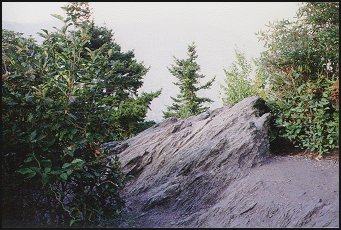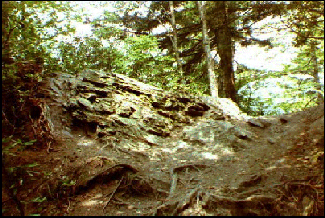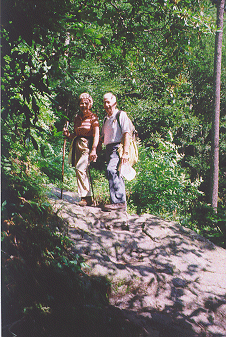View Mt. Leconte Hikes by Ed Wright in a larger map
Many of the landmarks that are mentioned in the hiking logs are my designations and do not appear on any map or in any official document. The trail map above is offered to assist the hiker in finding these locations.
The trailhead is about 3830′ above sea level. Once leaving the parking lot the trail crosses Walker Camp Prong and Alum Cave Creek via bridges. Historically this area was known as Grassy Patch and prior the establishment of the park, folks lived and farmed in this area. The trail continues along Alum Cave Creek. My half mile marker is a crooked tree that bends over the trail just before three rock steps. Three fourth miles up the trail is an open area with a large maple tree in middle of the trail. A few hundred yards later, the trail takes a sudden turn to the left and gets steeper. It then follows Styx Branch instead of Alum Creek. The foot logs are obvious and cross Styx Branch. Numbers of the footlogs depend upon my direction of travel. The first footlog is one mile above the trailhead. Just beyond the end of the second footlog is a large yellow buckeye tree. I believe that this is the largest tree along the Alum Cave Bluff Trail. My friend, the late Gene Hoffman is being used as a gauge for size.
Arch Rock is an obvious landmark. The top is about 4400′ elevation and 1.3 miles from the trailhead. Arch Rock is between the third and fourth footlog. The big washout of June 29th 1993 comes next. Inspiration Point two miles from the trailhead and follows the Washout. It is about 4700′ elevation and is an official designation. It is comprised of an out cropping of rocks that provide a view of Little Duck Hawk Ridge to the front and the Dolly Parton Peaks looking down the trail. The Dolly Parton Peaks have also been called “Boobs Ridge.” You can also see Myrtle Point from this location. It is above and to the left of Dolly Parton Peaks.
After taking a sharp right turn, the trail scales rocks and heads for the Alum Cave Bluff. Half way between Inspiration Point and Alum Cave Bluff the Eye of The Needle can be seen across the crevasse on Little Duck Hawk Ridge. Two holes in this ridge can be seen from Inspiration Point and from the lower parking lot. Big Duck Hawk Ridge is behind Little Duck Hawk Ridge.
A set of steps lead to Alum Cave Bluff which is 2.2 miles above the trailhead and an elevation of about 4950′. It is no cave at all, but a concaved cliff about eighty feet high and five hundred feet long. In winter icicles as large as a human body hang from the bluff. The hiker is warned that these icicles sometimes crashes onto the trail. Inside the bluff is a good location to rest and to get out of the rain.
The trail passes above the tops of Little Duck Hawk and Big Duck Hawk Ridges. There are manways across these ridges but they are closed because of the nesting peregrine falcons.
The half way point to the top of Mt. LeConte, is now called Gracie’s Pulpit. It is 2.5 miles above the trailhead and an elevation of about 5200′. It’s previous name was the Devil’s Pulpit, because it overlooks Hudgens Hell. Hudgens Hell is drained by Styx Branch. Both are official names. People renamed the half way point Gracie’s Pulpit in honor of the late Gracie McNicol. Great views of the four peaks of Mt. LeConte, that soar above 6200 feet, are clearly visible from this location when the weather is clear. These peaks are named West Point, Cliff Top, High Top, and Myrtle Point. At this location the trail levels out and actually drops about 80 to 100 feet to the saddles, There are three between Peregrine Peak and Mt. LeConte. Some people think that they have missed the trail because of this down hill section. The trail to the saddles is nice going up the mountain but tough on the return trip.
After the saddles the trail starts to climb again. At one steep climb, there were two dead tree stumps, Old Man’s Stump, on the right, that older fellows, like myself and the late Paul Dinwiddie, used the stumps to pull ourselves up the steep, rocky sections. These stumps were removed when the maintenance crew reworked the trail in 2001.This feature no longer exist, there is now a nice log with steps and a handrail that even I can scale.
A short distance beyond the new log steps, there is an open space with a tree trunk about eight feet above the trail and to the right. This is my three-mile point. About half way to the upper steps, there is a large rock outcropping that must be climbed. I call this Shirley’s Rock for Shirley Henry from Maryville. The trail crew chiseled steps in the rock to make it easier to climb and descend.
Next come the upper steps. They are at a switch back and are about 5700′ elevation. A few hundred yards above steps, was an area of very sharp, jagged rocks that were called “Bust @ss Rocks”. These rocks were sharp rock and formed a narrow ledge. Many people have fallen here. The area was vastly improved during trail rework in 2001 and the location really no longer presents an undue hazard to the hiker. Above that location the trail takes a sharp turn to the right. A tree with lots of roots to the left of the trail, provides a spot for hikers to sit and rest. This spot is Lu’s Pulpit, named for the late Ernest Luellen who suffered a fatal heart attack while hiking this trail.
Before reaching Grassy Slide a stream crosses the trail. It is officially called Trout Branch. Others call it Mossy Springs, because of all of the moss. I call it Little Niagara Falls, because of its horse shoe shape and quantity of water that gushes over the trail during rainstorms. Grassy Slide is four miles above the trailhead and a mile from the lodge. It is about 6,000′ above sea level and it is a large expanse of grass with good views of Newfound Gap, Gracie’s Pulpit, Clingmans Dome and the many layers of mountains stretching to North Carolina. There is now a second slide just beyond this location. During August and September many rare wildflowers bloom in this area. Included are Krigia Montana, Grass of Parnassus, St. John’s Wort, and closed gentian.
Continuing up the trail, the most Westerly, of the four peaks soaring above 6200 feet, comes into view. That peak is called West Point. At this location the hiker is almost at the same elevation and directly across a ravine from the peak. Hence that is why I call it West Point View. For the next fourth of a mile, the trail is immediately beneath Cliff Top. This area is on a narrow ledge and scares many hikers that suffer from acrophobia. It is quite safe and safety cables are available if they are needed.
There was once a barrier across the trail in the saddle between West Point and Cliff Top. This location is about 0.3 miles from the lodge and is called the site of the Old Horse Gate. It is about 6350′ elevation. The gate is gone today, but in preceding years it served to prevent horses with riders from descending into the dangerous sections of the Alum Cave Bluff Trail, where they would not be able turn back. Just before reaching the lodge the trail junctions with the Rainbow Falls/Bull Head Trails and the Boulevard Trail. This is the end of the Alum Cave Bluff Trail.
The lodge represents the end of may hikes, but the three remaining peaks are further up the trail. The trail passes a man made shelter that sleeps 12 people. The shelter must be reserved through the park service for a single nights use. Continuing up the trail the hiker reaches a clear rock face called Apollo Point. This location received its name from the days when viewers could see the Apollo Saturn V boosters climbing into orbit. A few hundred yards further is High Top. If you continue along the ridge you will reach Myrtle Point. This is the best location for sunrises and views of Douglas Lake. There are a couple of trails that lead to Cliff Top. This is the best location for panoramic views and to view sunsets.

The four peaks of Mt LeConte above 6000′ as seen looking south from the Gatlinburg Bypass.
The Alum Cave Bluff Trail is on the opposite side of the ridge as pictured in this photograph.
Balsam Point has an elevation 5818′.
High Top, elevation 6593, is the tallest of the four peaks. In fact the height of High Top fluctuates as the pile of stones atop it grows and shrinks. Views from this peak are obscured by trees. The final peak, Myrtle Point is still a fourth of mile away. The sign directing hikers to this peak is currently missing. The trail should be apparent as it crosses the ridge between the peaks. This trail is fairly flat and the hiker that looses much altitude has probably taken a wrong turn.
The five trails to the Lodge and their ratings are as follows:
1. Alum Cave Bluff Trail
5.5 miles. The shortest, fastest, steepest and the most scenic. 2700′ elevation change. Unquestionably my favorite trail.
2. Bull Head Trail
7.5 miles gradual, long. A nice trail for descending 4000′ elevation change. For a round trip hike go up Rainbow Falls Trail and hike down the Bull Head Trail. They both have the same parking lot at their trailheads.
3. Rainbow Falls
6.5 miles, rocky, steep, 4000′ elevation change. Too many loose rocks for a safe descent.
4. Trillium Gap Trail
6.5 miles, nice, Roaring Forks Road is very steep to the trailhead and back down to Gatlinburg. 3500′ elevation change. Beautiful walk under Grotto Falls.
5. The Boulevard Trail
8.8 miles. Many hikers think that the 1700 ‘ elevation change and the long distance means a gradual climb. Unfortunately the hike up has lots of ups and downs.





